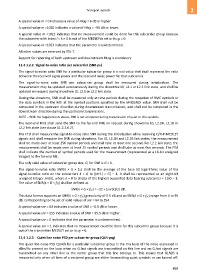Page 869 - 5G Basics - Core Network Aspects
P. 869
Transport aspects 2
A special value m = 0 indicates a value of Hlog = 6 dB or higher
A special value m =1020 indicates a value of Hlog = −96 dB or lower.
A special value m =1022 indicates that no measurement could be done for this subcarrier group because
the subcarrier with index i = k × G is out of the MEDLEYds set or its gi = 0.
A special value m =1023 indicates that the parameter is undetermined.
All other values are reserved by ITU-T.
Support for reporting of both upstream and downstream HLog is mandatory.
11.4.1.2.2 Signal-to-noise ratio per subcarrier (SNR-ps)
The signal-to-noise ratio SNR for a particular subcarrier group is a real value that shall represent the ratio
between the received signal power and the received noise power for that subcarrier.
The signal-to-noise ratio SNR per subcarrier group shall be measured during initialization. The
measurement may be updated autonomously during the showtime L0, L2.1 or L2.2 link state, and shall be
updated on request during showtime L0, L2.1 or L2.2 link state.
During the showtime, SNR shall be measured only at time periods during the reception of RMC symbols or
the data symbols in the NOI at the symbol positions specified by the MNDSNOI value. SNR shall not be
computed in the upstream direction during downstream transmissions, and shall not be computed in the
downstream direction during the upstream transmissions.
NOTE – With the requirements above, SNR is not computed during transmission of quiet or idle symbols.
The near-end FME shall send the SNR to the far-end FME on request during showtime L0, L2.1N, L2.1B or
L2.2 link state (see clause 11.2.2.6.2).
The FTU shall measure the signal-to-noise ratio SNR during the initialization while receiving O/R-P-MEDLEY
signals and shall measure the SNR during showtime. For L0, L2.1N and L2.1B link states, the measurement
shall be made over at least 256 symbol periods and shall take at most one second. For L2.2 link state, the
measurement shall be made over at least 25 symbol periods and shall take at most five seconds. The FTU
shall indicate the number of symbol periods used for the measurement (represented as a 16-bit unsigned
integer) to the far-end ME.
The only valid value of subcarrier group size, G, for SNR is G = 1.
The signal-to-noise ratio SNR(k × G × fSC) shall be the average of the base 10 logarithmic value of the
signal-to-noise ratio on the subcarriers k × G to ((k+1) × G) − 1. It shall be represented as an eight-bit
unsigned integer snr(k), where k = 0 to (index of the highest supported data bearing subcarrier + 1)/G – 1.
The value of SNR(k × G × fSC) shall be defined as
SNR(k × G × fSC) = −32 + (snr(k)/2) dB.
This data format supports an SNR(k × G × fSC) granularity of 0.5 dB and an SNR(k × G × fSC) range from 0 to 95
dB, corresponding to the set of valid values of snr = 64 to 254.
A special value snr = 63 indicates a value of SNR = –0.5 dB or lower.
A special value snr = 255 indicates a value of SNR = 95.5 dB or higher.
A special value snr = 0 indicates that the parameter is undetermined.
A special value snr = 1 indicates that no measurement could be done for this subcarrier group because it is
out of the transmitter MEDLEY set or its gi = 0.
11.4.1.2.3 Quiet line noise PSD per subcarrier group (QLN-psg)
The quiet line noise PSD QLN(f) for a particular subcarrier group is the rms level of the noise expressed in
dBm/Hz present on the loop when no G.fast signals are transmitted on this line and no G.fast signals are
transmitted on any other line in the vector group that this line belongs to. This means that QLN(f) is
measured only when all lines of a vectored group are either transmitting quiet symbols or are turned off.
859

